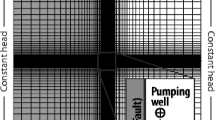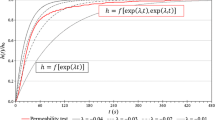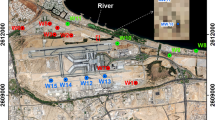Abstract
Transmissivity estimates derived from non-steady-state, single well, constant discharge, aquifer tests in laterally heterogeneous environments generally are questioned relative to their representativeness of aquifer conditions. Drawdown in pumping wells reflects the removal of water from storage in the aquifer and transient refraction of groundwater path-lines during the evolution of a non-symmetrical cone of depression. Simulations of single-well aquifer tests in aquifers with simple, arbitrary distributions of block heterogeneities suggest that transmissivity (T) values derived by the Cooper–Jacob (1946) method generally reflect volumetric, weighted mean T values of all of the heterogeneities contacted by the cone of depression at a particular time. This finding suggests that early-time drawdown data for single well aquifer tests reflect rapidly changing, volumetric, weighted mean T values proximal to the pumping well while late-time drawdown data reflect stabilized conditions and spatially averaged, volumetric weighted mean T out to a considerable distance from the pumping well.
Resumé
Les estimés de transmissivité dérivés d’essais de pompage en régime transitoire dans un seul puits contenu dans une formation latéralement hétérogène sont généralement questionable en ce qui concerne la représentativité des conditions de l’aquifère. Le rabattement dans les puits de pompage reflète l’extraction d’eau provenant de l’emmagasinement de l’aquifère et la réfraction en régime transitoire des lignes d’écoulement durant l’évolution d’un cone de dépression non symétrique. Des simulations d’essai de pompage dans un seul puits contenu dans un domaine avec des blocs hétérogènes distribués arbitrairement suggèrent que les valeurs de transmissivité obtenus avec la méthode d’interprétation de Cooper–Jacob (1946) sont généralement représentatifs du volume moyen pondéré de toutes les hétérogénéités en contact avec le cone de dépression à un temps particulier. Cette découverte suggère que les données de rabattement au début d’un essai pour un seul puits reflètent un changement rapide des valeurs moyennes proximales pondérées tandis que le rabattement à un temps tardif reflète les conditions stabilisées et la moyenne spatiale jusqu’à une distance considérable du puits de pompage.
Resume
Los estimados de transmisividad derivados de estados no estables, pozos individuales, descarga constante, pruebas de acuíferos en ambientes heterogéneos laterales generalmente se cuestionan en cuanto a su representatividad de las conidiones de los acuíferos. La extracción de agua en pozos de bombeo refleja la extracción de agua del depósito en el acuífero y la refracción transitoria de líneas de trayectoria del agua subterránea durante la evolución de un cono no simétrico de depresión. Las simulaciones de pozos individuales, pruebas de acuíferos en acuíferos con distribuciones simples, arbitrarias de heterogeneidades de bloque sugieren que los valores de transmisividad (T) derivados por el método Cooper–Jacob (1946) generalmente reflejan valores medios volumétricos potenciales (weighted) de todas las heterogeneidades en contaco con el cono de la depresión en un momento particular. Este descubrimiento sugiere que los datos de extracción tempranos de pruebas de pozos individuales reflejan valores medios potenciales volumétricos que cambian rápidamente en la proximidad del pozo de bombeo mientras que los valores de extracción tardíos reflejan condiciones estabilizadas y medias potenciales volumétricas a una distancia considerable del pozo de bombeo.







Similar content being viewed by others
References
Barker JA, Herbert R (1982) Pumping tests in patchy aquifers. Ground Water 20(2):150–155
Barrash W, Dougherty ME (1997) Modeling axially symmetric and nonsymmetric flow to a well with MODFLOW, and application to Goddard2 well test, Boise, Idaho. Ground Water 35(4):602–611
Bibby R (1977) Characteristics of pumping tests in heterogeneous clastic sediments, Edmonton, Alberta. Alberta Res Council Bull 35:31–39
Bibby R (1979) Estimating sustainable yield to a well in heterogeneous strata. Alberta Res Council Bull 37, Edmonton
Butler JJ Jr (1986) Pumping tests in nonuniform aquifers: a deterministic and stochastic analysis. PhD Thesis, Stanford University, Stanford, CA
Butler JJ Jr (1988) Pumping tests in nonuniform aquifers: the radially symmetric case. J Hydrol 101(1/4):15–30
Butler JJ Jr (1990) The role of pumping tests in site characterization: some theoretical considerations. Ground Water 28(3):394–402
Butler JJ Jr (1991) A stochastic analysis of pumping tests in laterally nonuniform media. Water Resour Res 27(9):2401–2414
Butler JJ Jr, Liu W (1993) Pumping tests in nonuniform aquifers: the radially asymmetric case. Water Resour Res 29(2):259–269
Butler JJ Jr, McElwee CD (1990) Variable-rate pumping tests for radially symmetric nonuniform aquifers. Water Resour Res 26(2):291–306
Cardwell WT, Parsons RL (1945) Average permeabilities of heterogeneous oil sands. Trans Am Inst Mining Metall Petrol Eng 160:34–42
Cooper HH Jr, Jacob CE (1946) A generalized graphical method for evaluating formation constants and summarizing well-field history. Eos Trans Am Geophys Union 27(4):526–534
Davis SN, DeWiest RJM (1966) Hydrogeology. Wiley, New York
Desbarats AJ (1992) Spatial averaging of transmissivity in heterogeneous fields with flow toward a well. Water Resour Res 28(3):757–767
Desbarats AJ (1993) Geostatistical analysis of interwell transmissivity in heterogeneous aquifers. Water Resour Res 29(4):1239–1246
Freeze RA (1975) A stochastic-conceptual analysis of one-dimensional groundwater flow in nonuniform homogeneous media. Water Resour Res 11(5):725–741
Golden Software, Inc (1999) SURFER 7. Golden, Colorado
McDonald MG, Harbaugh AW (1988) A modular three-dimensional finite-difference ground-water flow model. Book 6, techniques of water resources investigations of the US Geol Survey
McElwee CD, MA Yukler (1978) Sensitivity of groundwater models with respect to variations in transmissivity and storage. Water Resour Res 14(3):451–459
Meier PM, Carrera J, Sánchez-Vila X (1998) An evaluation of Jacob’s method for the interpretation of pumping tests in heterogeneous formations. Water Resour Res 34(5):1011–1025
Meier PM, Carrera J, Sánchez-Vila X (1999) A numerical study of the relationship between transmissivity and specific capacity in heterogeneous aquifers. Ground Water 37(4):611–617
Naff RL (1991) Radial flow in heterogeneous porous media: an analysis of specific discharge. Water Resour Res 27(3):307–316
Oliver DS (1993) The influence of nonuniform transmissivity and storativity on drawdown. Water Resour Res 29(1):169–178
Osiensky JL, Williams RE, Williams B, Johnson G (2000) Evaluation of drawdown curves derived from multiple well aquifer tests in heterogeneous environments. Mine water and the environment. Int Mine Water Assoc 19(1):30–55
Sánchez-Vila X, Meier PM, Carrera J (1999) Pumping tests in heterogeneous aquifers: an analytical study of what can be obtained from their interpretation using Jacob’s method. Water Resour Res 35(4):943–952
Schad H, Teutsch G (1994) Effects of the investigation scale on pumping test results in heterogeneous porous aquifers. J Hydrol 159:61–77
Serrano SE (1997) The Theis solution in heterogeneous aquifers. Ground Water 35(3):463–467
Streltsova TD (1988) Well testing in heterogeneous formations. Wiley, New York
Theis CV (1935) The relation between the lowering of the piezometric surface and the rate and duration of discharge of a well using ground-water storage. Eos Trans Am Geophys Union 16:519–524
Toth J (1966) Groundwater, geology, movement, chemistry and resources, near Olds, Alberta. Research Council of Alberta Bulletin 17, Edmonton
Vandenberg A (1977) Pump testing in heterogeneous aquifers. J Hydrol 34:45–62
Warren JE, Price HS (1961) Flow in heterogeneous porous media. Soc Petrol Eng J 1(3):153–169
Waterloo Hydrogeologic, Inc (2000) Visual Modflow. Developed by Nilson Guiguer and Thomas Franz, Waterloo, Ontario, Canada
Acknowledgement
We would like to express our sincere appreciation to referees Philippe Renard and Peter Meier, and Associate Editor Simon Loew for their reviews and suggestions for improving the paper. Their contributions to the content of the paper are greatly appreciated.
Author information
Authors and Affiliations
Corresponding author
Rights and permissions
About this article
Cite this article
Tumlinson, L.G., Osiensky, J.L. & Fairley, J.P. Numerical evaluation of pumping well transmissivity estimates in laterally heterogeneous formations. Hydrogeol J 14, 21–30 (2006). https://doi.org/10.1007/s10040-004-0386-5
Received:
Accepted:
Published:
Issue Date:
DOI: https://doi.org/10.1007/s10040-004-0386-5




